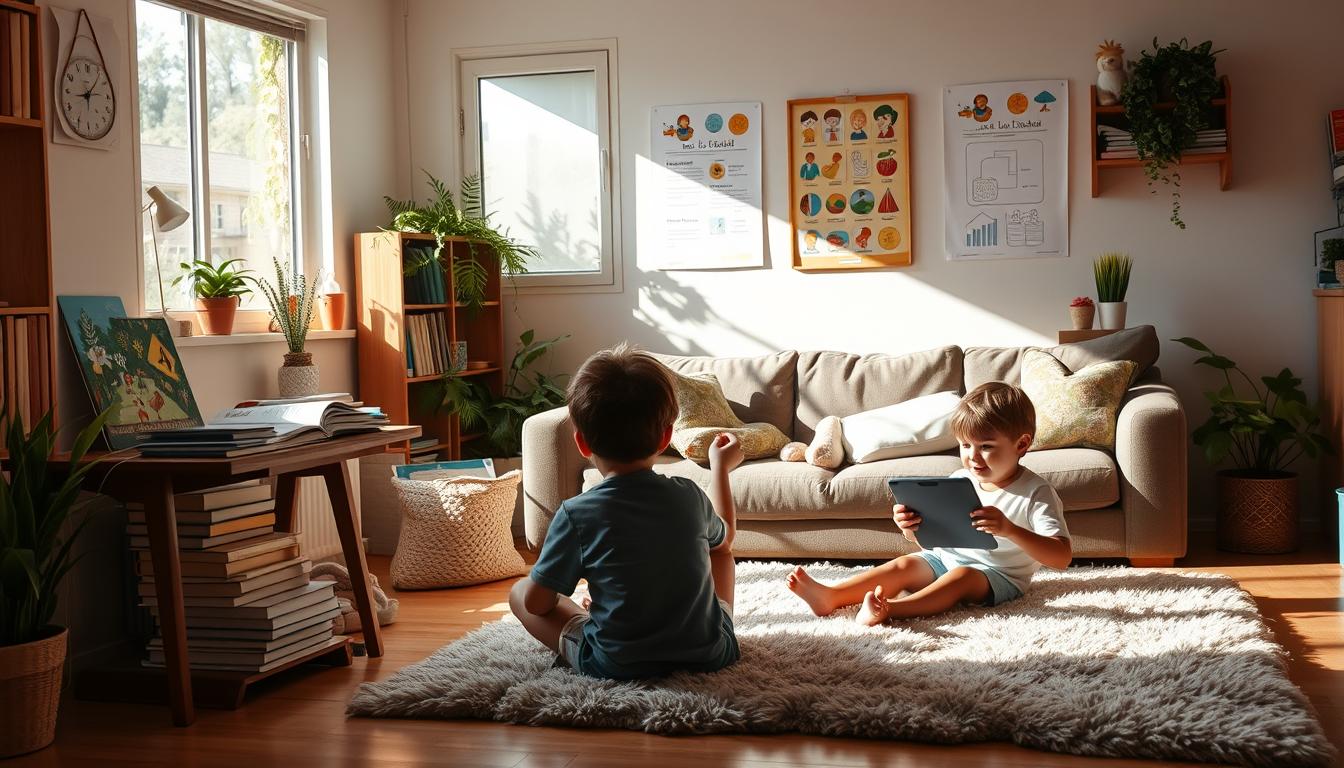In today’s world, kids screen time has increased a lot. You might ask, “What’s the right mix between school and digital devices for kids?” Kids use their phones about 72 times a day. They spend around 43 minutes on screens for school tasks. It’s key to think about how this affects their learning and happiness.
Parents, teachers, and kids all need to find a balance. This balance is important in today’s digital age.
Even though screens can help with learning, too much can be bad. It can mess with sleep and make kids overweight. The American Academy of Pediatrics says no screens for kids under 18 months. For kids 18 to 24 months, it’s best to limit it.
For older kids, they should not spend more than an hour on screens daily. So, how do you follow these rules and still use screens for learning?
Key Takeaways
- Children pick up their phones an average of 72 times daily, with a median of 237 notifications.
- The SAMR model provides a framework for efficient digital integration in classrooms.
- Limiting screen time to no more than one hour per day is recommended by the American Academy of Pediatrics.
- Interactive and active screen experiences enhance children’s engagement and education.
- Balancing screen time with offline activities and outdoor play is crucial for sensory development.
Understanding the Importance of Media Balance
Finding the right balance for media use in children is key. It’s not about strict limits but making sure screen time helps their growth. Families need practical tips to manage kids’ media use well.
Media Balance in Education
Media balance is vital for all children. Youngest learners, 2 and below, should have little screen time. They should watch high-quality educational media with an adult nearby.
Children aged 2 to 5 can have up to one hour of screen time daily. This should be interactive and educational. It’s crucial for teaching consent and sports coaching.
For older kids, media use should not replace sleep, family time, or exercise. Teachers can use technology to improve learning. But, it’s important to avoid distractions. Setting rules for screen use helps kids make better choices.
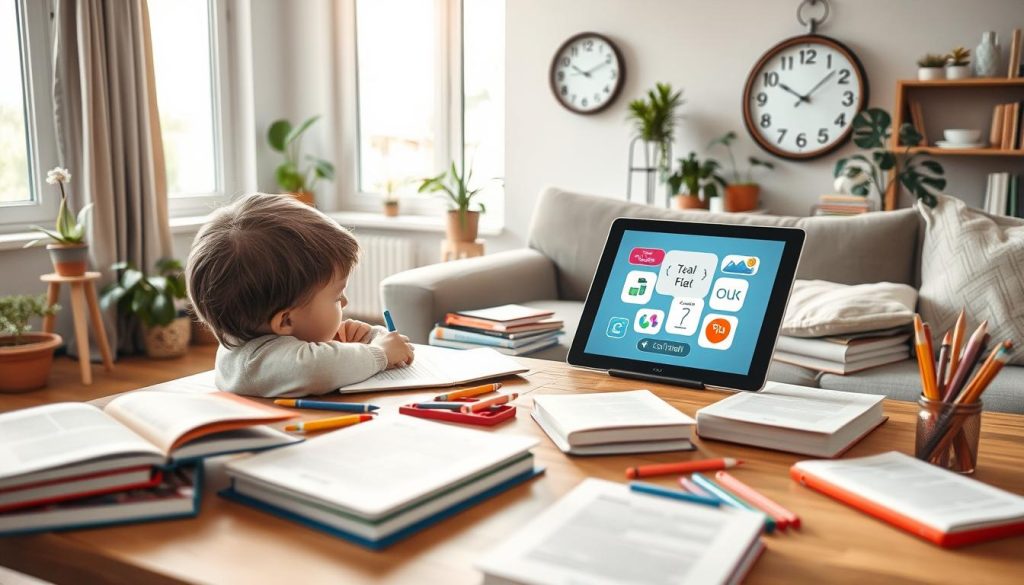
When and Where to Use Screens
Deciding when and where kids use screens is important. Devices should not be in bedrooms to improve sleep. Make sure there are media-free zones in the house.
Encourage activities without screens, like family dinners or outdoor play. This helps with anxiety. Turning off devices an hour before bed reduces blue light and improves sleep.
Parents should watch how much media kids use, especially tweens and teens. Talk about online safety and set rules for screen use. These steps help keep a healthy media balance and support kids’ growth.
Be Purposeful About Screen Use
It’s key to make sure screens help kids learn, not just distract them. Being careful about what they watch and do online can really help their education.
Experts like the American Academy of Pediatrics and the World Health Organization say kids should watch screens less. Kids 2-5 should watch no more than an hour a day. And kids under 2 should only watch video calls.
In the 1980s, kids watched TV for about 25 hours a week, as much as they went to school. Now, screens are everywhere, even for babies as young as six months. This shows how important it is to use screens wisely, like for learning with e-books.
Looking at how divorce and children affect families, we see the need for rules about screen time. This is true for middle child syndrome and when talking about puberty. Teaching kids to choose content that helps them grow is key.
Setting limits on screen time is also vital. Using screens for learning can balance out just playing on them. This way, kids learn to use technology in a good way, not just as a way to pass time.
Using screens wisely in families, especially in stepchild situations or during tough times like divorce, can bring stability. It helps avoid problems like middle child syndrome or talking about puberty. By planning how screens fit into their lives, you make sure they’re used for good.
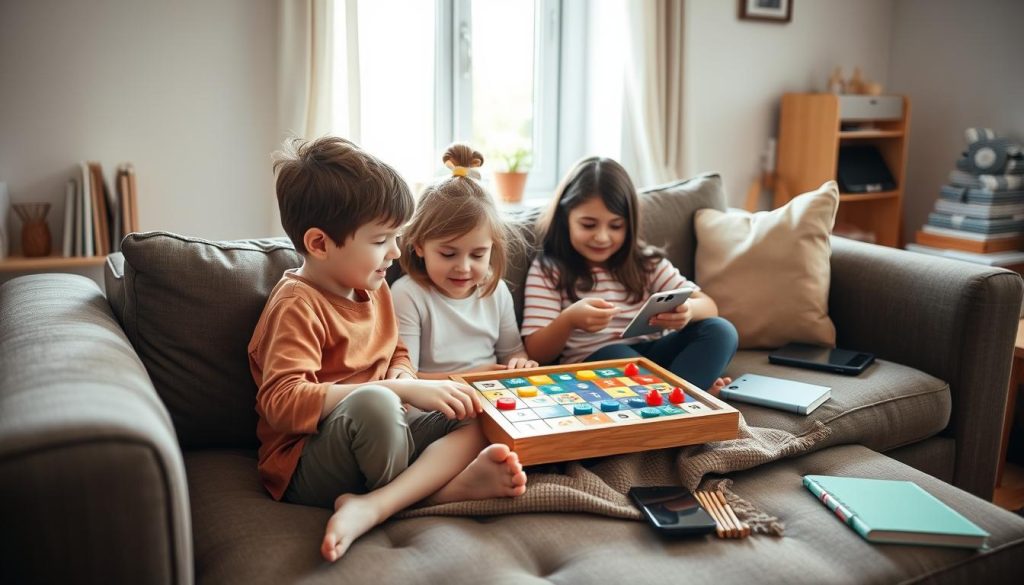
Strategies to Minimize Distractions
Creating effective ways to reduce distractions can greatly improve focus and learning for kids. With kids using their phones over 9,000 times a day, finding a balance is key. It’s important to make time for activities that help them grow.
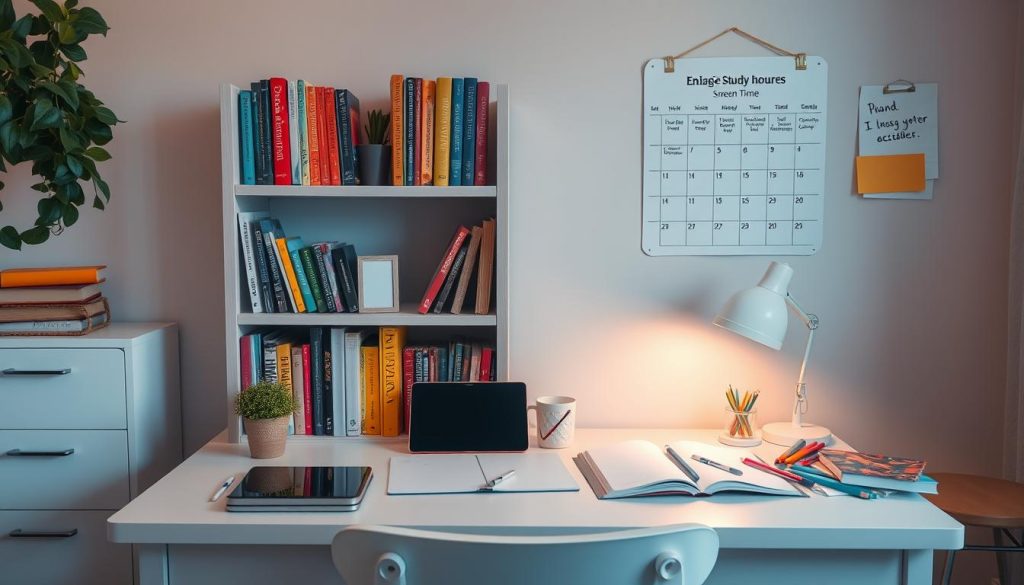
Implement Clear Phone Policies
Setting clear phone rules is a smart move. Studies show multitasking can cut productivity by 40% and slow down tasks by 50%. So, having rules like checking phones only at the hour can help a lot. It keeps kids focused and teaches them how to use phones wisely.
The American Academy of Pediatrics suggests kids aged 2 to 5 should watch screens for only one hour a day. This helps prevent distractions and keeps their attention sharp. Also, not using devices during meals or before bed helps kids connect better with their family.
Productivity and Focus Techniques
Using the Pomodoro method can boost productivity. It involves working in focused 25-minute blocks, then taking short breaks. This method works well for both kids and adults, helping them stay on track.
Parents should also make time to give their kids their full attention. This strengthens their bond and helps kids stay focused. Getting kids involved in sports is another great way to keep them active and focused, like Olympic swimmer Michael Phelps did with his ADHD.
Tips for Parents: Managing Kids’ Screen Time
Managing your kids’ screen time is tough in today’s digital world. Parents spend about 70-80 hours a week on this task. But, with the right strategies, you can help your kids balance their screen time and improve family life.
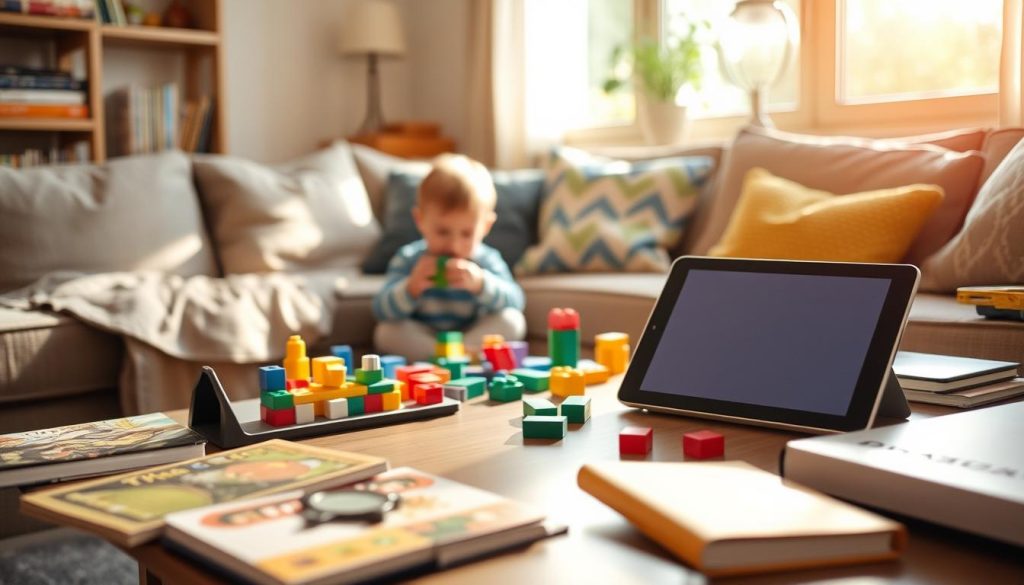
Set Screen-Free Times
It’s important to set times when screens are off. The American Academy of Pediatrics says kids aged 2 to 5 should watch only one hour of quality TV a day. Make sure screens are off during meals or before bed.
This helps your family bond and have important talks. You can discuss things like talking to kids about drugs and family budgeting. It also lets kids do other fun things.
Encourage Offline Activities
Getting your kids to do things offline is good for them. Activities like exercise, reading, or playing board games are great. They help kids stay active and healthy.
They also give you a chance to talk about important stuff. Like kids and social media safety and family budgeting. Studies show that using screens wisely can be positive.
For new moms, finding the right balance is crucial. Good screen-time management can change how much kids use screens. They might spend more time reading and less gaming.
By following these tips, you help your kids live healthier lives. You also make your home a happier place. This leads to better family dynamics and overall well-being.
Health Effects of Too Much Screen Time
Screens are a big part of our lives today, especially for kids. But too much screen time can be harmful. Studies show it affects how well kids can focus and manage their emotions.
Impact on Sleep
Too much screen time can mess up sleep. The blue light from screens stops the body from making melatonin, which helps us sleep. Kids who watch screens a lot before bed often have trouble sleeping well.
Research by Pagani et al. has shown that watching TV too early can harm kids’ well-being. This includes problems with sleep.
Physical and Mental Health Risks
Too much screen time can also harm kids’ bodies and minds. Studies by Lissak have found links to anxiety, depression, and even obesity. Parents face challenges in balancing screen time with teaching kids to be positive about their bodies.
Stiglic and Viner’s review found that too much screen time can lead to more obesity and anxiety in kids. It’s important to understand how screen time affects kids differently. For example, boys and girls may react differently to screens, affecting their emotional growth.
It’s crucial to find ways to reduce these negative effects. Encouraging kids to spend time in nature can help lower anxiety and stress from screens.
Incorporating Educational Content into Screen Time
Today, finding the right balance between screen time and its downsides is a big parenting challenge. But, making screen time interactive and educational can really help your child learn more. By choosing high-quality educational content, kids can learn alongside their favorite shows. YouTube Kids and PBS Kids are great for this, but remember to turn off autoplay to keep things safe.
More families are using tablets, with a huge jump from 4% to 45% between 2010 and 2015. By picking apps and videos that match school curriculums, like at The Step by Step School, parents can make screen time educational. It’s also key to set limits on screen time to keep things balanced. Apps that teach kids about consent are a great way to teach important life lessons while having fun.
Screen time can also help kids think critically and be creative. This can be balanced with outdoor play and hands-on activities for a well-rounded development. With 68% of Americans having a smartphone, adding educational apps to daily routines is easier. Coaching kids in sports can also help, improving both physical and mental health.
Research shows that cutting down on screen time can work. A study of 29 studies found a big drop in screen time, with eight of those happening at home. Setting clear limits helps kids understand the importance of balance. The American Academy of Pediatrics agrees, saying we should be mindful of how much media we use.
Parenting Challenges: Finding Balance
Parenting today means balancing screen time for learning and fun. Gentle parenting helps find this balance. It ensures kids grow in a caring environment. It also meets the need for eco-friendly parenting that respects family and nature.
Balancing Educational and Recreational Screen Use
It’s important to keep screen time for learning and fun separate but equal. Gentle parenting teaches kids to be responsible and engaged. Watching shows together can make screen time educational and fun.
Finding the right balance helps keep the peace at home. It reduces sibling rivalry and makes for a calm home.
Consistency and Rules Around Screen Use
Setting clear rules for screen time is vital. Screens should not be in bedrooms, and there should be set times for them. These rules are key, especially in online family therapy, where they support mental health.
A consistent routine is helpful for everyone. It makes life easier for kids and parents. A child services educator with 15 years of experience says it keeps discipline and positive behavior in check.
Setting boundaries is also important for work and parenting. Women often do more parenting, but sharing duties is key. Having a supportive network of working parents is helpful. Taking care of yourself and being kind to yourself keeps you going as a working parent.
Conclusion
Finding the right balance between school and screen time for your child is a big challenge. It’s important for parents to use many strategies and be flexible. This helps keep up with family changes and new technology.
Good parenting means being consistent and quality in your methods. This affects how well your child does in school and their emotional health.
We looked at many tips for parents. These include making rules, encouraging activities without screens, and using educational content. Studies show that parents’ involvement is key for kids’ success in school.
For example, a study by Jeynes (2012) found that parents greatly impact urban students’ success. Another study by Katz et al. (2011) showed how parents teach kids healthy habits.
Being a modern parent, especially in stepfamily situations, requires special strategies. Research by Leyendecker et al. (2002) and Panter-Brick et al. (2014) suggest that consistent support and positive interaction are crucial. These actions help kids deal with emotional and cognitive challenges.
Setting limits on screen time and promoting healthy habits is always a challenge. As technology and society change, so must our parenting. This ensures peace and harmony in our homes.
FAQ
What is the significance of finding a balance between school and screen time?
How can educators achieve media balance in the classroom?
What are some strategies for parents to manage their kids’ screen time?
How does excessive screen time affect a child’s health?
What are some effective techniques to minimize distractions from personal devices in classrooms?
How can educational content be incorporated into screen time for children?
What are some tips for encouraging offline activities in children?
How can parents maintain consistency in screen use rules?
What resources are available for online family therapy to address digital media challenges?
How can gentle parenting techniques help manage kids’ screen time?
This post contains affiliate links. If you click on a link and make a purchase, I may earn a small commission — at no extra cost to you. Thank you for supporting this blog and helping me keep the patterns free! Read the full Affiliate Disclosure & Transparency.
